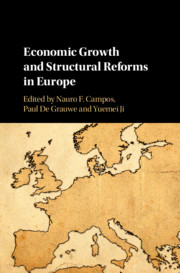Book contents
- Economic Growth and Structural Reforms in Europe
- Economic Growth and Structural Reforms in Europe
- Copyright page
- Contents
- Figures
- Tables
- Contributors
- Introduction
- Part I Economic Growth and Structural Reforms in Europe
- Part II Macroeconomic Implications of Reforms
- 4 Heterogeneous Market Regulation and Divergence in a Currency Union
- 5 Macroeconomic Imbalances in the Euro Area
- 6 Financial Crises and Liberalization
- 7 Structural Reforms and Fiscal Sustainability
- 8 Transitions in the EU Labour Market before and after the Crisis
- 9 On the Complementarity between Labour Market Regulation and Tax Reforms in the European Union
- Part III Case Studies
- Conclusions
- Index
- References
4 - Heterogeneous Market Regulation and Divergence in a Currency Union
from Part II - Macroeconomic Implications of Reforms
Published online by Cambridge University Press: 31 March 2020
- Economic Growth and Structural Reforms in Europe
- Economic Growth and Structural Reforms in Europe
- Copyright page
- Contents
- Figures
- Tables
- Contributors
- Introduction
- Part I Economic Growth and Structural Reforms in Europe
- Part II Macroeconomic Implications of Reforms
- 4 Heterogeneous Market Regulation and Divergence in a Currency Union
- 5 Macroeconomic Imbalances in the Euro Area
- 6 Financial Crises and Liberalization
- 7 Structural Reforms and Fiscal Sustainability
- 8 Transitions in the EU Labour Market before and after the Crisis
- 9 On the Complementarity between Labour Market Regulation and Tax Reforms in the European Union
- Part III Case Studies
- Conclusions
- Index
- References
Summary
A potential driver of real income divergence across members of a currency union is their regulatory environment. We focus on the role of product and labor market regulations and assess their effects on long-term growth and on the adjustment to shocks in a two-country currency union DSGE model with endogenous growth. With endogenous growth, there is no reason to expect real income convergence. When regulation varies across countries, real income can diverge permanently, because different market regulations lead to different levels of investment in productivity enhancing technologies. This in turn causes different trend growth and inflation pressures. Furthermore, under symmetric shocks, heterogeneous regulation can cause temporary, but persistent divergence of output and inflation. The results are consistent with the disappointing productivity growth and inflation rates experienced in less reform-friendly union members in the euro area and suggest that differences in market regulation can play an important role for both long-run and short-run divergence in response to shocks.
Keywords
- Type
- Chapter
- Information
- Economic Growth and Structural Reforms in Europe , pp. 111 - 140Publisher: Cambridge University PressPrint publication year: 2020

